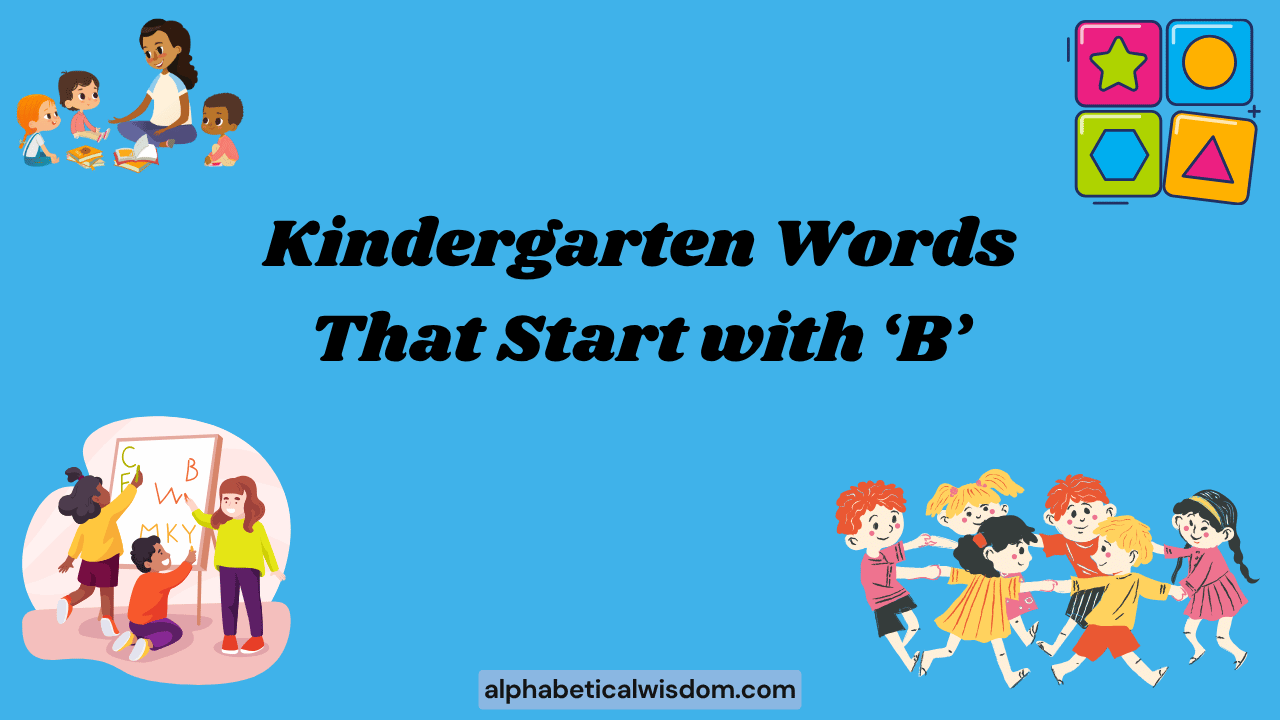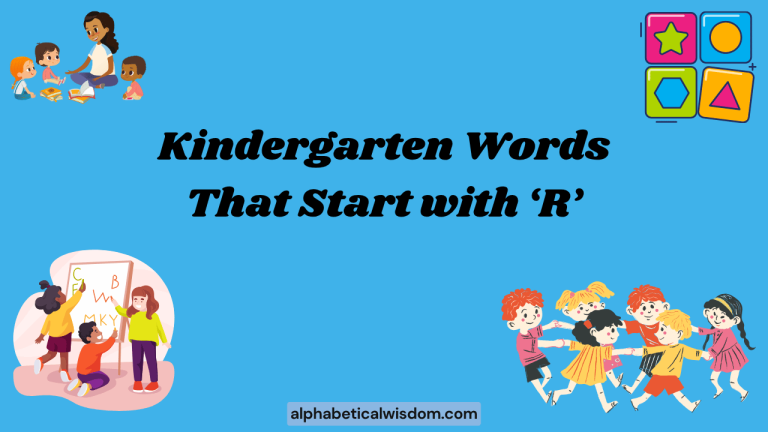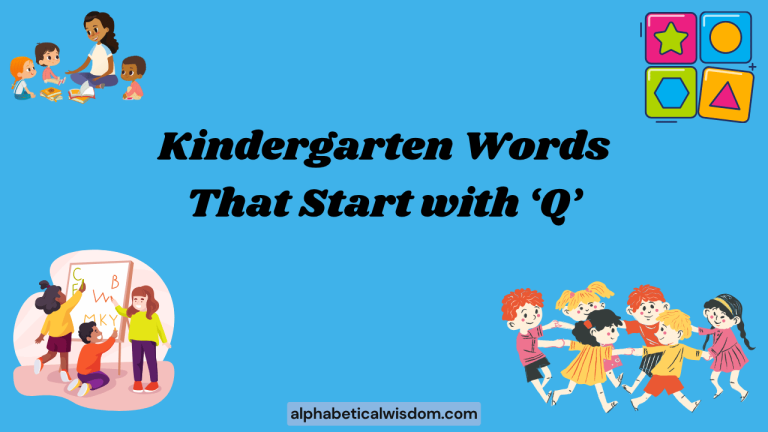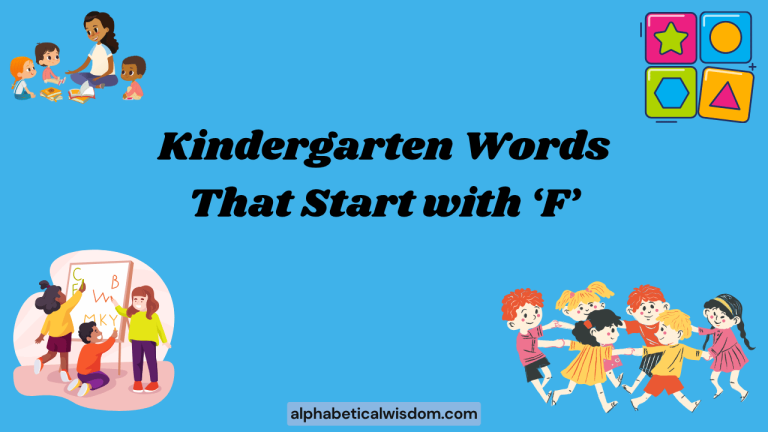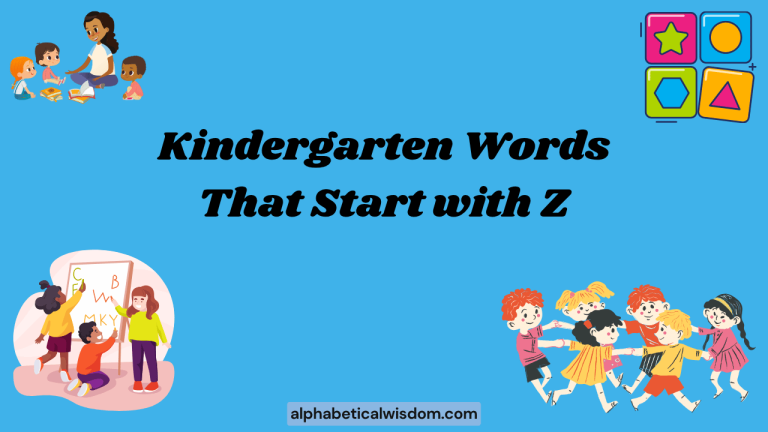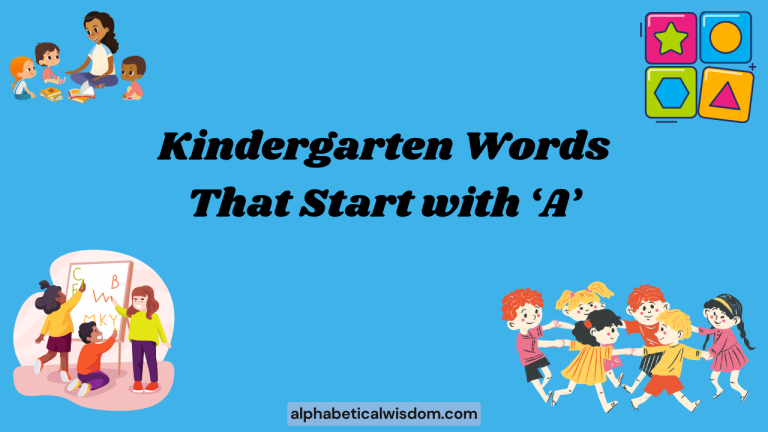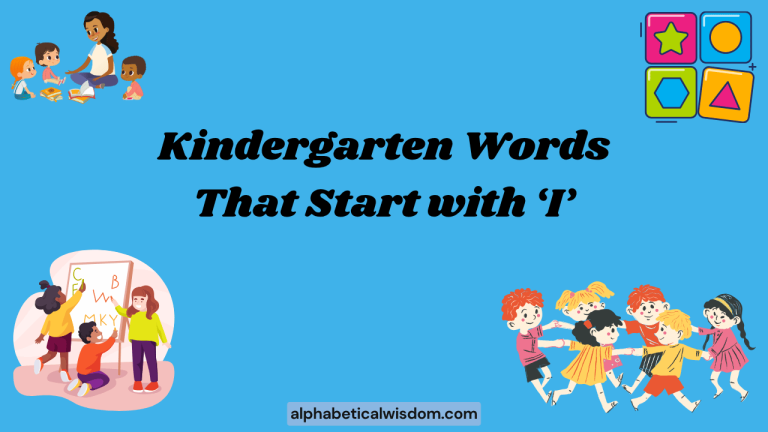Kindergarten Words That Start With B: A Comprehensive Guide
Understanding words that begin with the letter ‘B’ is a fundamental step in a child’s literacy journey. These words form the building blocks of early reading and writing skills, enabling young learners to express themselves and comprehend the world around them.
This article provides a comprehensive overview of kindergarten-friendly ‘B’ words, offering definitions, examples, and practical exercises to aid in their mastery. It is designed for parents, educators, and anyone supporting early childhood education.
Table of Contents
- Introduction
- Definition of Kindergarten Words Starting With ‘B’
- Structural Breakdown of ‘B’ Words
- Types and Categories of ‘B’ Words
- Examples of Kindergarten ‘B’ Words
- Usage Rules for ‘B’ Words
- Common Mistakes When Using ‘B’ Words
- Practice Exercises
- Advanced Topics
- Frequently Asked Questions
- Conclusion
Definition of Kindergarten Words Starting With ‘B’
Kindergarten words starting with the letter ‘B’ are basic vocabulary items that young children are typically introduced to in their early years of schooling. These words are carefully selected to be developmentally appropriate, focusing on concrete nouns, simple verbs, and descriptive adjectives that are relevant to a child’s everyday experiences.
They help children build a foundation in phonics, vocabulary, and early literacy skills. These words are often monosyllabic or disyllabic, making them easier to pronounce and remember.
The primary function of these words is to enable children to communicate effectively, understand simple instructions, and begin to express their thoughts and ideas in written form. By mastering these words, children gain confidence in their language abilities, which in turn supports their overall academic development.
The context in which these words are introduced is usually within familiar themes such as family, animals, food, and everyday activities.
Structural Breakdown of ‘B’ Words
Understanding the structural elements of words starting with ‘B’ involves recognizing the sound-letter correspondence and the common patterns they follow. The letter ‘B’ typically represents the /b/ sound, which is a voiced bilabial stop.
This means that the sound is produced by bringing both lips together and releasing air. When analyzing ‘B’ words, it’s helpful to break them down into their individual phonemes (sounds) and graphemes (letters).
Many ‘B’ words in kindergarten follow simple consonant-vowel-consonant (CVC) patterns, such as bat, big, and bus. Others may have consonant blends at the beginning, like black or brown. Recognizing these patterns helps children decode and encode words more effectively. Furthermore, understanding the common vowel sounds associated with these words is crucial for accurate pronunciation and spelling. For example, the short ‘a’ sound in bat is different from the long ‘e’ sound (silent ‘e’) in bike (though bike is generally a grade 2/3 word).
Types and Categories of ‘B’ Words
Classifying ‘B’ words into different categories based on their grammatical function helps children understand how these words are used in sentences. The main categories include nouns (naming words), verbs (action words), and adjectives (describing words).
Nouns
Nouns are words that represent people, places, things, or ideas. Kindergarten ‘B’ nouns often refer to concrete objects or animals that children can easily identify. Examples include ball, bear, book, box, and bird. These nouns are essential for building a child’s vocabulary and understanding of the world.
Verbs
Verbs are words that describe actions or states of being. ‘B’ verbs for kindergarten might include bounce, build, bring, and bite. These verbs help children understand how things move and interact. It is important to teach these verbs in context to help children understand their meaning.
Adjectives
Adjectives are words that describe nouns, providing more information about their qualities or characteristics. Examples of ‘B’ adjectives for kindergarten include big, blue, brave, and busy. These adjectives help children develop their descriptive language skills and add detail to their sentences.
Examples of Kindergarten ‘B’ Words
Providing numerous examples of ‘B’ words is crucial for reinforcing their meaning and usage. These examples are categorized to help children understand the different contexts in which these words can be used.
Everyday Objects
Here are some examples of everyday objects that start with the letter ‘B’. These are items commonly found in a child’s environment.
| Word | Example Sentence |
|---|---|
| Ball | The ball is red. |
| Book | I like to read a book. |
| Box | The toys are in the box. |
| Bed | I sleep in my bed. |
| Bike | I ride my bike in the park. |
| Blocks | We build a tower with blocks. |
| Basket | The basket is full of fruit. |
| Balloon | The balloon is floating in the air. |
| Belt | I wear a belt with my pants. |
| Bowl | I eat cereal from a bowl. |
| Brush | I use a brush to comb my hair. |
| Button | My shirt has a blue button. |
| Band | The band played music at the party. |
| Bracelet | She wears a shiny bracelet. |
| Blanket | I snuggle with my blanket when it’s cold. |
| Board | We write on the board in class. |
| Boots | I wear boots when it rains. |
| Bottle | I drink water from a bottle. |
| Bread | I eat bread with butter. |
| Bridge | The car drove over the bridge. |
| Bell | The school bell rings to start class. |
| Bench | We sat on the bench in the park. |
| Bib | The baby wears a bib while eating. |
| Bin | Throw the trash in the bin. |
| Biscuit | I ate a biscuit with my tea. |
Animals
Here are some examples of animals that start with the letter ‘B’. Learning about animals is a fun way for children to expand their vocabulary.
| Word | Example Sentence |
|---|---|
| Bear | The bear lives in the forest. |
| Bird | The bird is singing in the tree. |
| Bee | The bee makes honey. |
| Butterfly | The butterfly is flying in the garden. |
| Bunny | The bunny hops in the grass. |
| Beaver | The beaver builds dams. |
| Bass | The bass swam in the lake. |
| Bat | The bat flies at night. |
| Beetle | The beetle crawled on the leaf. |
| Buffalo | The buffalo grazed on the prairie. |
| Bulldog | The bulldog is a friendly dog. |
| Bluebird | The bluebird is a beautiful bird. |
| Bobcat | The bobcat is a wild cat. |
| Bumblebee | The bumblebee buzzed around the flower. |
| Barracuda | The barracuda is a large fish. |
| Barnacle | The barnacle stuck to the rock. |
| Badger | The badger dug a hole. |
| Bison | The bison roamed the plains. |
| Boa | The boa constrictor is a large snake. |
| Bongo | The bongo is a type of antelope. |
| Bunting | The bunting is a colorful bird. |
| Budgie | The budgie chirped in its cage. |
| Brant | The brant is a type of goose. |
| Boxfish | The boxfish has a unique shape. |
| Brittany | The brittany is a type of dog. |
Actions
Here are some examples of action words (verbs) that start with the letter ‘B’. These words describe things that people and animals do.
| Word | Example Sentence |
|---|---|
| Bounce | The ball can bounce high. |
| Build | We can build a tower with blocks. |
| Bring | Please bring me the book. |
| Bite | Don’t bite your nails. |
| Blow | I can blow bubbles. |
| Brush | I brush my teeth every morning. |
| Bake | We will bake cookies for dessert. |
| Bathe | I bathe before bedtime. |
| Beg | The dog will beg for a treat. |
| Bend | I can bend down and touch my toes. |
| Boil | We boil water to make tea. |
| Bow | We bow to show respect. |
| Braid | She will braid her hair. |
| Breathe | Remember to breathe deeply. |
| Bubble | The water will bubble when it boils. |
| Buzz | The bees buzz around the flowers. |
| Balance | I try to balance on one foot. |
| Ban | They will ban the use of plastic bags. |
| Bargain | We can bargain for a better price. |
| Bark | The dog will bark at strangers. |
| Bat | He can bat the ball very far. |
| Beam | The sun will beam through the clouds. |
| Bear | I cannot bear to see anyone sad. |
| Beat | She will beat the eggs for the cake. |
| Become | I hope to become a doctor someday. |
Descriptive Words
Here are some examples of descriptive words (adjectives) that start with the letter ‘B’. These words describe the qualities of nouns.
| Word | Example Sentence |
|---|---|
| Big | The elephant is very big. |
| Blue | The sky is blue. |
| Brave | The knight is brave. |
| Busy | The bee is busy collecting nectar. |
| Bright | The sun is bright today. |
| Beautiful | The flower is beautiful. |
| Bad | That was a bad decision. |
| Bitter | The coffee is bitter without sugar. |
| Black | The cat is black. |
| Bold | He is a bold leader. |
| Boring | The movie was boring. |
| Bottom | The toy is at the bottom of the box. |
| Breezy | The weather is breezy today. |
| Brief | The meeting was brief. |
| Broad | The river is very broad. |
| Broken | The toy is broken. |
| Bronze | The statue is made of bronze. |
| Brown | The bear is brown. |
| Brutal | The game was brutal. |
| Blunt | The pencil is blunt. |
| Bashful | The child is bashful. |
| Barren | The land is barren. |
| Beneficial | Exercise is beneficial for health. |
| Best | He is the best player. |
| Bewildered | I am bewildered by the question. |
Food
Here are some examples of food items that start with the letter ‘B’. Exploring food-related words can be both educational and fun.
| Word | Example Sentence |
|---|---|
| Bread | I eat bread with butter. |
| Banana | I like to eat a banana for breakfast. |
| Beans | We eat beans with rice. |
| Berries | I love to eat fresh berries. |
| Biscuit | I ate a biscuit with my tea. |
| Bacon | I eat bacon with eggs. |
| Bagel | I had a bagel with cream cheese. |
| Barley | We made soup with barley. |
| Basil | The pizza is topped with fresh basil. |
| Batter | I mixed the batter for the pancakes. |
| Beef | We had beef for dinner. |
| Beet | I added beet to the salad. |
| Broccoli | I like to eat broccoli with cheese. |
| Brownie | I ate a chocolate brownie. |
| Butter | I spread butter on my toast. |
| Buttermilk | I used buttermilk to make the biscuits. |
| Blackberries | We picked blackberries in the forest. |
| Blueberries | I added blueberries to my yogurt. |
| Bran | I eat bran cereal for breakfast. |
| Bruschetta | We ate bruschetta as an appetizer. |
| Baguette | I bought a fresh baguette from the bakery. |
| Baklava | We ate baklava for dessert. |
| Baloney | I made a baloney sandwich. |
| Bangers | We had bangers and mash for dinner. |
| Biscotti | I dipped the biscotti in my coffee. |
Usage Rules for ‘B’ Words
Understanding the grammatical rules for using ‘B’ words is essential for constructing correct sentences. Nouns, verbs, and adjectives each follow specific rules regarding their placement and function within a sentence.
Nouns can act as subjects, objects, or complements. Verbs describe the action performed by the subject.
Adjectives modify nouns, providing descriptive details.
For example, in the sentence “The big bear eats berries,” ‘bear’ is a noun acting as the subject, ‘eats’ is a verb, and ‘big’ is an adjective modifying the noun ‘bear’. Pay attention to subject-verb agreement and adjective placement to ensure grammatical accuracy. For instance, it would be incorrect to say “Bear big eats berries.”
Common Mistakes When Using ‘B’ Words
Common mistakes when using ‘B’ words often involve misspellings, incorrect pronunciation, or using the wrong word in a sentence. For example, confusing ‘blue’ with ‘blew’ is a common error due to their similar sounds but different meanings.
Another mistake is misspelling simple words like ‘bear’ as ‘bare’.
Here are some examples of common mistakes and their corrections:
| Incorrect | Correct | Explanation |
|---|---|---|
| I see a bare. | I see a bear. | ‘Bare’ means uncovered, while ‘bear’ is an animal. |
| The sky is blew. | The sky is blue. | ‘Blew’ is the past tense of ‘blow’, while ‘blue’ is a color. |
| I bot a book. | I bought a book. | ‘Bot’ is incorrect, the correct word is ‘bought’. |
| The byke is red. | The bike is red. | ‘Byke’ is a misspelling of ‘bike’. |
| The babby is sleeping. | The baby is sleeping. | ‘Babby’ is a misspelling of ‘baby’. |
| I want a blew balloon. | I want a blue balloon. | ‘Blew’ is the past tense of ‘blow’, while ‘blue’ is a color. |
| The bord is green. | The board is green. | ‘Bord’ is a misspelling of ‘board’. |
| I like to bayth. | I like to bathe. | ‘Bayth’ is a misspelling of ‘bathe’. |
| The berd is singing. | The bird is singing. | ‘Berd’ is a misspelling of ‘bird’. |
| I can bounse the ball. | I can bounce the ball. | ‘Bounse’ is a misspelling of ‘bounce’. |
Practice Exercises
Engaging in practice exercises helps reinforce the learning of ‘B’ words. These exercises are designed to test comprehension and application of these words in different contexts.
Exercise 1: Fill in the Blanks
Complete the following sentences with the correct ‘B’ word from the word bank. Word Bank: ball, book, bed, box, bird
| Question | Answer |
|---|---|
| 1. I sleep in my _____. | bed |
| 2. The _____ is singing in the tree. | bird |
| 3. The toys are in the _____. | box |
| 4. I like to read a _____. | book |
| 5. The _____ is red. | ball |
| 6. I keep my toys in a _____. | box |
| 7. The little _____ flew away. | bird |
| 8. I read a story before _____. | bed |
| 9. I bounce the _____ high. | ball |
| 10. My favorite _____ is about animals. | book |
Exercise 2: Matching
Match the ‘B’ word with its correct definition.
| Word | Definition | Answer |
|---|---|---|
| 1. Big | a. A place to sleep | 1. d |
| 2. Blue | b. An animal that flies | 2. e |
| 3. Bird | c. A container | 3. b |
| 4. Box | d. Large in size | 4. c |
| 5. Bed | e. A color | 5. a |
| 6. Brave | f. A round object | 6. h |
| 7. Book | g. To construct something | 7. i |
| 8. Ball | h. Not afraid | 8. f |
| 9. Build | i. A set of pages bound together | 9. g |
| 10. Busy | j. Actively engaged | 10. j |
Exercise 3: Sentence Creation
Create a sentence using each of the following ‘B’ words.
| Word | Example Sentence |
|---|---|
| 1. Ball | I like to play with the red ball. |
| 2. Book | The book has many colorful pictures. |
| 3. Blue | The blue sky is beautiful today. |
| 4. Bear | The bear is sleeping in its cave. |
| 5. Build | We will build a sandcastle at the beach. |
| 6. Big | The big elephant has large ears. |
| 7. Bring | Please bring me a glass of water. |
| 8. Brave | The brave knight rescued the princess. |
| 9. Bounce | I can bounce the ball very high. |
| 10. Box | The box is full of toys. |
Advanced Topics
For advanced learners, exploring more complex aspects of ‘B’ words can deepen their understanding of the English language. This includes examining the etymology (origin) of these words, understanding their usage in idioms and figurative language, and exploring more advanced vocabulary that begins with ‘B’.
For instance, understanding the historical context of words like “benevolent” or “banish” can provide a richer appreciation of their meaning and usage.
Furthermore, advanced learners can explore the nuances of pronunciation, such as the silent ‘b’ in words like “bomb” or “debt.” Analyzing the subtle differences in meaning between words that are similar but not identical (e.g., “bring” vs. “take”) can also enhance their linguistic skills.
Additionally, studying the use of ‘B’ words in literature and poetry can provide a deeper understanding of their artistic and expressive potential.
Frequently Asked Questions
- Why is it important for kindergarteners to learn words starting with ‘B’?Learning ‘B’ words helps build a strong foundation in phonics, vocabulary, and early literacy skills. It enables children to communicate effectively, understand simple instructions, and express their thoughts in written form, boosting their confidence and overall academic development.
- What are some effective strategies for teaching ‘B’ words to young children?Effective strategies include using visual aids like flashcards, incorporating ‘B’ words into interactive games and activities, reading books that feature these words prominently, and encouraging children to use these words in everyday conversations. Multisensory approaches, such as tracing the letter ‘B’ in sand or using playdough to form ‘B’ words, can also be beneficial.
- How can parents support their child’s learning of ‘B’ words at home?Parents can support their child by creating a print-rich environment with labels on common household items, reading aloud regularly, playing word games, and providing opportunities for writing and drawing. Encouraging children to ask questions and explore new words can also foster a love of learning.
- What are common challenges children face when learning ‘B’ words, and how can they be addressed?Common challenges include difficulty distinguishing the /b/ sound from other similar sounds, misspellings, and confusion about word meanings. These challenges can be addressed through targeted phonics instruction, regular practice with spelling and vocabulary exercises, and providing clear explanations and examples of word usage.
- Are there any specific ‘B’ words that are particularly useful for kindergarteners to learn first?Yes, starting with simple, concrete nouns like ball, book, bear, and box is often effective. These words are easily recognizable and relevant to a child’s everyday experiences. Simple verbs like bounce and adjectives like big and blue are also good starting points.
- How can technology be used to enhance the learning of ‘B’ words?Technology offers various tools for enhancing learning, including educational apps, interactive websites, and online games that focus on phonics, vocabulary, and reading comprehension. These resources can provide engaging and personalized learning experiences, track progress, and offer immediate feedback.
- What is the role of repetition in mastering ‘B’ words?Repetition is crucial for mastering new vocabulary. Repeated exposure to ‘B’ words through reading, writing, and speaking helps reinforce their meaning and pronunciation, making them more easily accessible and memorable.
- How can teachers assess a child’s understanding of ‘B’ words?Teachers can assess understanding through various methods, including oral assessments, written tests, and observation during classroom activities. Asking children to use ‘B’ words in sentences, identify them in stories, or match them with their definitions can provide valuable insights into their comprehension.
- How can I make learning ‘B’ words fun and engaging?Make learning fun by incorporating games, songs, and hands-on activities. Use flashcards with colorful pictures, create a ‘B’ word scavenger hunt, or have children act out the meaning of different ‘B’ words. The key is to make the learning experience interactive and enjoyable.
- What are some common idioms that use words starting with ‘B’, and how can they be taught?Some common idioms include “bite the bullet,” “break the ice,” and “barking up the wrong tree.” These can be taught by explaining their figurative meaning in context, providing examples of their usage, and encouraging children to create their own sentences using the idioms.
Conclusion
Mastering kindergarten words that start with the letter ‘B’ is a critical step in a child’s early literacy development. These words serve as the foundation for more complex language skills, enabling children to communicate effectively and confidently.
By providing a comprehensive understanding of these words, this article aims to support parents and educators in their efforts to foster a love of learning and a strong foundation in English language skills.
Remember to use a variety of teaching strategies, incorporate repetition, and make learning fun and engaging. Encourage children to practice using these words in different contexts and provide ongoing support and encouragement.
With consistent effort and a positive learning environment, children can successfully master ‘B’ words and embark on a lifelong journey of literacy and language acquisition.
